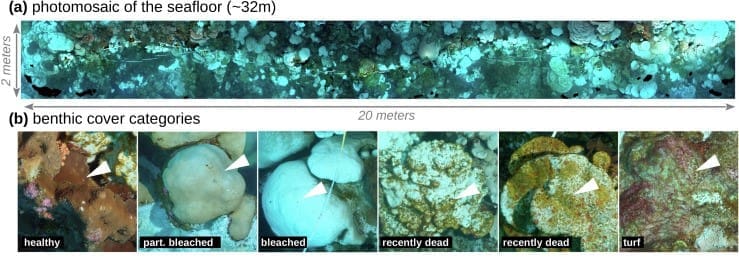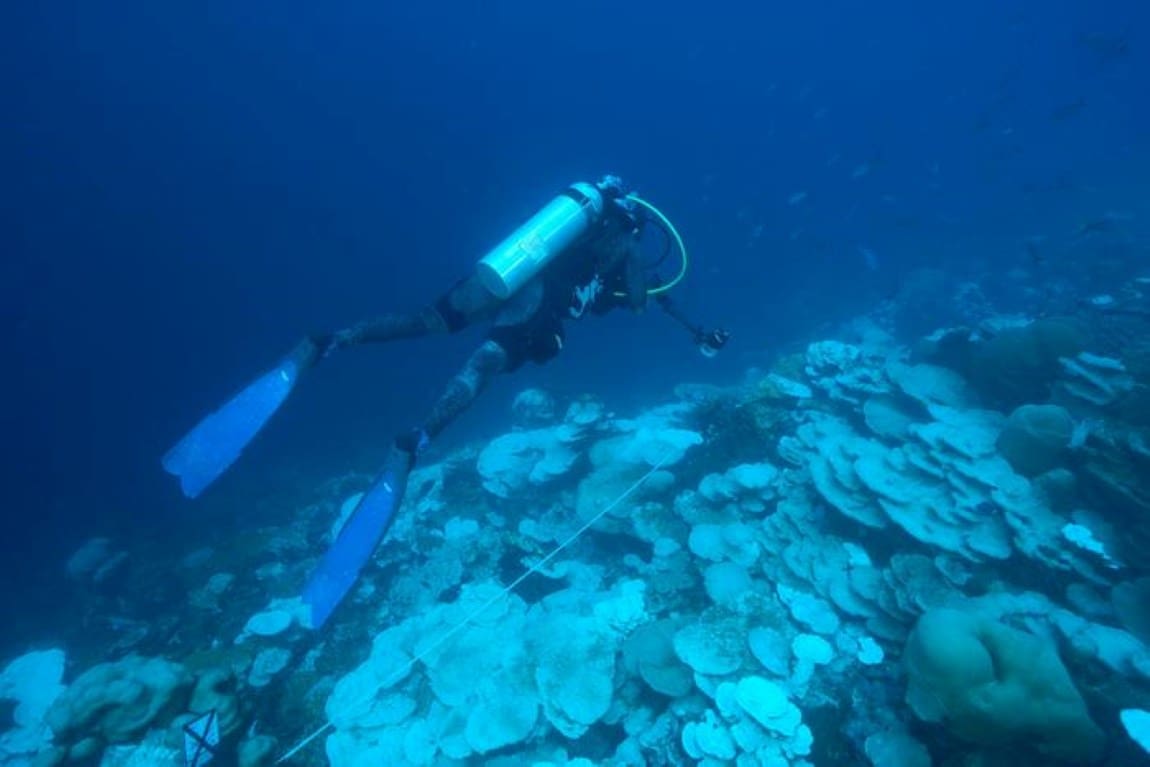New study highlights that deep coral ecosystems in the Eastern Pacific likely face a two-pronged threat over the 21st century: bleaching driven by the intrusion of warm water from above and by cold water from below.
Researchers from the Max Planck Institute for Chemistry (MPIC) recently published a paper detailing their observations of a major coral bleaching and mortality event that occurred on the deep reefs of the Clipperton Atoll, a remote coral island in the Eastern Tropical Pacific.
This bleaching, which was highly unexpected, is driven by the upwards displacement of cold water to much shallow depths than normal. The researchers link the presence of this anomalously shallow, cold water to changes in easterly wind strength in the Pacific, and demonstrate that the variability in wind strength can explain other past observed bleaching events of shallow reefs in the Eastern Tropical Pacific.
Their study, which was recently published in the scientific journal Science of the Total Environment, highlights that cold-water bleaching may prove to be a major threat to deep reef ecosystems over the 21st century.

A disturbing surprise in the remote Eastern Pacific
Alan Foreman and Nicholas Duprey, two postdoctoral researchers from Alfredo Martínez-García’s group at the Max Planck Institute for Chemistry in Mainz, conducted a scientific expedition to Clipperton Atoll in early 2023 to collect samples from Clipperton’s shallow reefs.
This work, conducted onboard the sailing yacht S/Y Acadia as part of a collaboration with the Rohr Foundation, was aimed at retrieving coral cores and water samples in an area that will allow MPIC researchers to reconstruct changes in the size of oxygen minimum zones in the Eastern Pacific over the 20th century.
“Clipperton is a truly remote destination: 800 nautical miles south of Mexico and 1000 nautical miles west of Costa Rica,” explains Nicolas Duprey. “Although we were in the area to collect other samples, serendipitously we observed bleaching on the deep coral reefs on one of our first dives,” recalls Alan. “From the temperature of the surrounding water, we were able to infer that this was almost certainly driven by the presence of cold water,” adds Nic.
This was indeed quite a surprise to the two paleoclimatologists, considering that Clipperton is located in an area of the Pacific known for its warm water, with an average surface water temperature of 28°C for most of the year.
How to quantify a massive bleaching event 30 meters underwater
With assistance in the field from study coauthors Mark Rohr, Rose Dodwell, and Guy Dodwell, the two scientists began documenting the extensive bleaching present around Clipperton, both by recording the percentage of bleached and dead coral at 32 meters depth (~70 percent) and by photographing the bleaching in high resolution.
With help from Matan Yuval at the University of Haifa, they merged the huge photo collection into one single image, a so-called a photomosaic, for further analysis back on dry land. When combined with temperature measurements of the upper 300 meters of the water column, it became clear that the deep corals were bleaching due to cold shock, and that this shock played a large part in was leading to substantial mortality along the deep reefs.
Assisted by Marielle Dumestre (MPIC), the researchers compiled a database of published cold- and warm-water bleaching events that occurred in the shallow reefs of the region to better elucidate the role of cold-water intrusions in governing reef ecosystem functionality. It turned out that the timing of cold-water bleaching events coincided with past maxima in easterly wind strength.
“We quickly realized that this anomalously cold water so high in the water column was linked to oscillations in easterly wind strength in the Eastern Tropical Pacific,” says Alan. This link suggests that any future intensification of easterly winds in the Pacific may be a significant threat for its mesophotic coral ecosystems, as it could drive severe bleaching via increased exposure to colder waters from depth.
Mesophotic coral reefs are facing dual threats in the 21st century
Recent studies suggest that major La Niña events associated with strong easterly winds will become both stronger and more frequent in the near future. Models also predict that extreme La Niña events will follow extreme El Niño events more often. The researchers hypothesize, that, if this becomes a reality, unusually cold water will be displaced onto Eastern Tropical Pacific deep and mid-depth reefs on the heels of increased warm thermal stress from the surface.
The authors of the study fear that, given the severity of bleaching and the associated coral mortality seen at Clipperton, the impact of cold-water bleaching on deep coral reefs is not transient, and that such events could strongly impact the health and functionality of a given deep-water reef.
“Our observations, in combination with recent reports of warm-water bleaching of Red Sea and Indian Ocean mesophotic coral ecosystems, highlight that 21st century mesophotic coral ecosystems in the Eastern Pacific face a two-pronged challenge: warm-water bleaching from above, and cold-water bleaching from below,” Alan concludes.
***
Coral Bleaching: The corals expel single-celled algae that they need to survive. As a result, they lose their color and often starve to death. Read more: https://www.mpg.de/21887931/coral-bleaching
Mesophotic coral ecosystems exist in low light — “meso” means middle and “photic” refers to light. Read more: https://oceanservice.noaa.gov/facts/mesophotic.html
Funding:
Beyond funding by the Max Planck Society, the field expedition and research was made possible in major part by The Rohr Foundation. Other funders include the Deutsche Forschungsgemeinschaft (DFG, German Research Foundation) – Project number 468591845 – SPP 2299/Project number 441832482; the Paul Crutzen Nobel Prize Fellowship; the Leona M. and Harry B. Helmsley Charitable Trust; the Maurice Hatter Foundation; the Data Science Research Center at the University of Haifa; the Murray Foundation for student research; Microsoft AI for Earth: AI for Coral Reef Mapping.
Journal Reference:
Alan D. Foreman, Nicolas N. Duprey, Matan Yuval, Marielle Dumestre, Jennifer N. Leichliter, Mark C. Rohr, Rose C.A. Dodwell, Guy A.S. Dodwell, Eric E.G. Clua, Tali Treibitz, Alfredo Martínez-García, ‘Severe cold-water bleaching of a deep-water reef underscores future challenges for Mesophotic Coral Ecosystems’, Science of The Total Environment 951, 175210 (2024). DOI: 10.1016/j.scitotenv.2024.175210
Article Source:
Press Release/Material by Max Planck Institute for Chemistry
Featured image: Expedition diver Rose Dodwell documenting the extent of coral bleaching along a transect at 32 meters depth (white transect tape is visible in the middle of the image). Credit: Mark Rohr | CC BY




